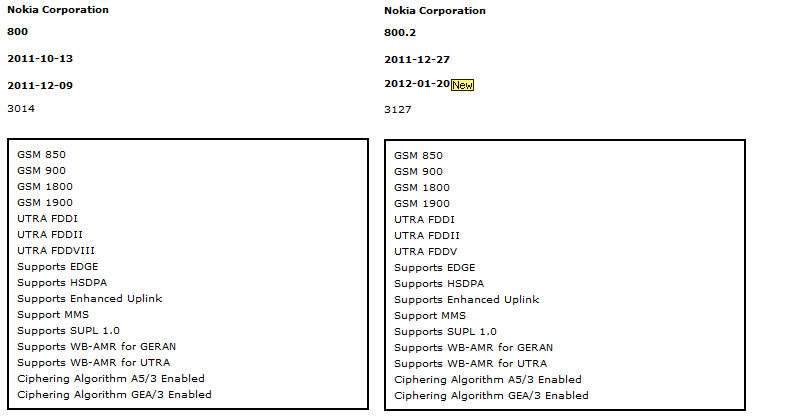Most consumers will never have to worry about phone variants. The phone they buy from their operator will be the 'right' variant. However, if you choose to import a phone or buy a phone overseas this is something you may need to take into consideration. After all you'll most likely want a device that has full 3G support on your home network.
Buying a Nokia Lumia 800 in the US is a good example of where this problem might occur. It's not officially available in the US, but plenty of online retailers will import one for you. In this case you will almost certainly get a European or Asian version. However, Nokia have now announced that the Lumia 800, from February, will be sold in the US through Microsoft's stores (and other select retailers) and these devices will be a US specific variant.
WCDMA Bands
Smartphone that are sold globally will have multiple variants because 3G networks around the world do not use the same frequencies (bands). This is due to spectrum licensing and regulatory issues.
It is also worth noting that it is not unusual for an operator to have a network that uses multiple bands. Again regulatory and frequency licensing issues play a role, but the different bands also have different propagation characteristics that mean they are suitable for different scenarios.
The end result is that phones must support multiple bands, but doing so does incur a cost, which is why most phones typically support three or four 3G bands.
As you might expect the bands supported by a phone are generally dictated by what bands are used in the market in which it is sold or by the operator selling the device. There's a summary of which bands are used where below, but do note that there are plenty of exceptions to these generalisations.
- Band I (2100 MHz) - Europe, Africa, Asia, Oceania
- Band II (1900 MHz) - Americas
- Band IV (1700 MHz) - USA (T-Mobile) and a few others
- Band V (850 Mhz) - Americas
- Band VIII (900 Mhz) - Europe, Asia, Oceania
Some phones (e.g. all of Nokia's Symbian^3 devices), known as penta-band devices, do support all five of the common 3G bands (I, II, IV, V and VIII). However, a combination of aerial engineering complexity, cost and lack of consumer demand means that penta-band has not had as widespread adoption as you might expect.
It is much more common for phones to support three bands. This means, for any device that is sold globally, there are usually at least two variants - one for European/Africa/Asia and one for the Americas.
Lumia Device variants
The Nokia Lumia 710 variants are listed on Nokia's developer site as RM-803 (Global) and RM-809 (T-Mobile US). The global variant, also known as 710, is a tri-band device, supporting Bands I, II and VII. The T-Mobile US variant, also known as 710.1 is a quad-band device, supporting Bands I, II, IV and V.
The Nokia Lumia 800 also has at least two known variants - RM-801 (Global) and RM-819 (US). The global variant, also known as 800, is a tri-band device, supporting Bands I, II and VII. The US variant is a tri-band device, supporting Bands I, II and V.
There may also be a third Nokia Lumia 800 variant - the 800.2. As noted by the::unwired the Global Certification Forum (GCF) recently certified the Nokia 800.2, a device with WCDMA Band I, II and V support (same as 800.1). It is currently unclear what are the differences between the 800.1 and 800.2. However, it is one of these two variants that will be going on sale in the US and Canada shortly.

GCF notes on the Nokia 800 and Nokia 800.2
Nokia Lumia 800 variants
RM-801 / 800 - Global - GSM 850/900/1800/1900 MHz, WCDMA (3G) Band I (2100), Band II (1900), Band VIII (900)
RM-819 / 800.1 - US - GSM 850/900/1800/1900 MHz, WCDMA (3G) Band I (2100), Band II (1900), Band V (850)
800.2 - GSM 850/900/1800/1900 MHz, WCDMA (3G) Band I (2100), Band II (1900), and Band V (850)
Nokia Lumia 710 variants
RM-803 / 710 - Global - GSM 850/900/1800/1900 MHz, WCDMA (3G) Band I (2100), Band II (1900), Band VIII (900)
RM-809 / 710.1 - T-Mobile US - GSM 850/900/1800/1900 MHz, WCDMA (3G) Band I (2100), Band II (1900), Band IV (1700/2100), and Band V (850)
